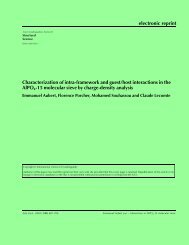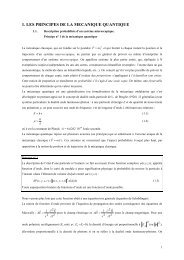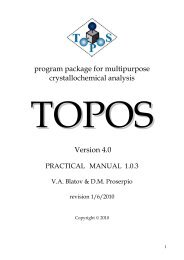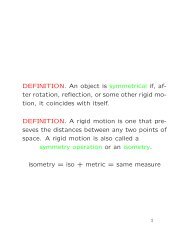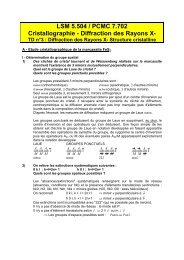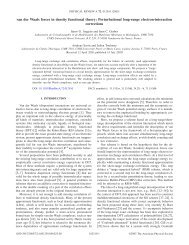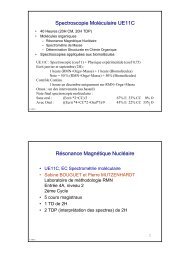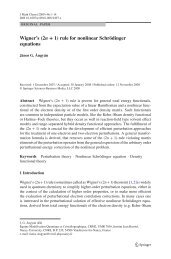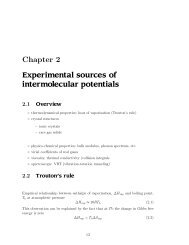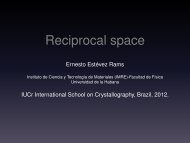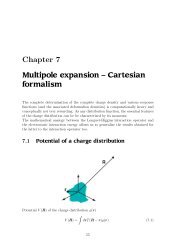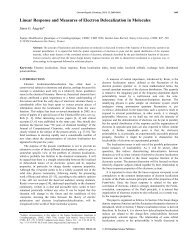1 Exercice 1 Repérer le pic de base et le pic moléculaire. Chercher ...
1 Exercice 1 Repérer le pic de base et le pic moléculaire. Chercher ...
1 Exercice 1 Repérer le pic de base et le pic moléculaire. Chercher ...
You also want an ePaper? Increase the reach of your titles
YUMPU automatically turns print PDFs into web optimized ePapers that Google loves.
<strong>Exercice</strong> 1<br />
<strong>Repérer</strong> <strong>le</strong> <strong>pic</strong> <strong>de</strong> <strong>base</strong> <strong>et</strong> <strong>le</strong> <strong>pic</strong> <strong>moléculaire</strong>.<br />
<strong>Chercher</strong> à i<strong>de</strong>ntifier <strong>le</strong> composé dont il s’agit. Pour cela, faire <strong>de</strong>s essais d’addition <strong>de</strong> masse<br />
<strong>de</strong>s atomes rentrant dans la composition <strong>de</strong> molécu<strong>le</strong>s organiques tel<strong>le</strong>s que C, H, O, N, tout<br />
en respectant <strong>le</strong>s <strong>base</strong>s <strong>de</strong> la chimie organique (va<strong>le</strong>nce <strong>de</strong>s atome).<br />
<strong>Exercice</strong> 2<br />
<strong>Repérer</strong> <strong>le</strong> <strong>pic</strong> <strong>de</strong> <strong>base</strong> <strong>et</strong> <strong>le</strong> <strong>pic</strong> <strong>moléculaire</strong>.<br />
<strong>Chercher</strong> à i<strong>de</strong>ntifier <strong>le</strong> composé dont il s’agit. Pour cela, faire <strong>de</strong>s essais d’addition <strong>de</strong> masse<br />
<strong>de</strong>s atomes rentrant dans la composition <strong>de</strong> molécu<strong>le</strong>s organiques tel<strong>le</strong>s que C, H, O, N, tout<br />
en respectant <strong>le</strong>s <strong>base</strong>s <strong>de</strong> la chimie organique (va<strong>le</strong>nce <strong>de</strong>s atome).<br />
1
<strong>Exercice</strong> 3<br />
Ce spectre correspond à un mélange : <strong>de</strong> quels composés ?<br />
<strong>Exercice</strong> 4<br />
<strong>Repérer</strong> <strong>le</strong> <strong>pic</strong> <strong>de</strong> <strong>base</strong> <strong>et</strong> <strong>le</strong> <strong>pic</strong> <strong>moléculaire</strong>.<br />
<strong>Chercher</strong> à i<strong>de</strong>ntifier <strong>le</strong> composé dont il s’agit. Pour cela, faire <strong>de</strong>s essais d’addition <strong>de</strong> masse<br />
<strong>de</strong>s atomes rentrant dans la composition <strong>de</strong> molécu<strong>le</strong>s organiques tel<strong>le</strong>s que C, H, O, N, tout<br />
en respectant <strong>le</strong>s <strong>base</strong>s <strong>de</strong> la chimie organique (va<strong>le</strong>nce <strong>de</strong>s atome).<br />
2
<strong>Exercice</strong> 5<br />
Le spectre ci-<strong>de</strong>ssous correspond à un composé organique <strong>de</strong> masse <strong>moléculaire</strong> 72<br />
(dépourvu d’atome d’azote).<br />
a) En normalisant à 100% l’abondance du fragment <strong>de</strong> m/z=72, l’abondance du <strong>pic</strong><br />
m/z=73 est alors <strong>de</strong> 4.45%. Calcu<strong>le</strong>r <strong>le</strong> nombre d’atomes <strong>de</strong> carbone <strong>de</strong> la molécu<strong>le</strong>.<br />
b) Expliquer l’origine <strong>de</strong>s <strong>pic</strong>s suivants : m/z=29, m/z=43, m/z=57 <strong>et</strong> m/z=72.<br />
c) Donner une formu<strong>le</strong> développée possib<strong>le</strong> pour <strong>le</strong> composé.<br />
d) Est-ce la seu<strong>le</strong> formu<strong>le</strong> développée possib<strong>le</strong> ? si non, pourquoi r<strong>et</strong>enir c<strong>et</strong>te formu<strong>le</strong><br />
plutôt qu’un autre ?<br />
<strong>Exercice</strong> 6<br />
Les trois spectres ci-<strong>de</strong>ssous correspon<strong>de</strong>nt à 3 isomères <strong>de</strong> formu<strong>le</strong> brute C4H10O. Leur<br />
masse <strong>moléculaire</strong> est <strong>de</strong> 74.<br />
Dans chaque cas, reconnaître <strong>le</strong>s <strong>pic</strong>s dominants <strong>et</strong> <strong>le</strong>s fragments perdus.<br />
Attribuer à chaque formu<strong>le</strong> développée <strong>le</strong> spectre correspondant.<br />
HO<br />
C<br />
H 3<br />
molécu<strong>le</strong> a<br />
CH 3<br />
C<br />
H 3<br />
molécu<strong>le</strong> b<br />
OH<br />
C<br />
H 3<br />
HO<br />
CH 3<br />
molécu<strong>le</strong> c<br />
CH 3<br />
3
spectre 1 spectre 2 spectre 3<br />
<strong>Exercice</strong> 7<br />
Parmi <strong>le</strong>s molécu<strong>le</strong>s suivantes, quel<strong>le</strong>s sont cel<strong>le</strong>s pour <strong>le</strong>squel<strong>le</strong>s on <strong>de</strong>vrait voir un <strong>pic</strong><br />
correspondant à un réarrangement <strong>de</strong> McLafferty ?<br />
Donner la structure du fragment chargé <strong>et</strong> la va<strong>le</strong>ur <strong>de</strong> m/z.<br />
a)<br />
C<br />
H 3<br />
b)<br />
C<br />
H 3<br />
O<br />
O<br />
O<br />
CH 3<br />
CH 3<br />
H3C c)<br />
C<br />
H 3<br />
Voici <strong>le</strong>s spectres correspondants à 3 <strong>de</strong>s 4 molécu<strong>le</strong>s étudiées.<br />
Attribuer chacun <strong>de</strong>s spectres à la molécu<strong>le</strong> qui convient.<br />
d)<br />
CH 3<br />
O<br />
O<br />
H<br />
CH 3<br />
4
spectre 1<br />
spectre 2<br />
spectre 3<br />
5
<strong>Exercice</strong> 8<br />
<strong>Repérer</strong> <strong>le</strong> <strong>pic</strong> <strong>de</strong> <strong>base</strong> <strong>et</strong> <strong>le</strong> <strong>pic</strong> <strong>moléculaire</strong>.<br />
<strong>Chercher</strong> à i<strong>de</strong>ntifier <strong>le</strong> composé dont il s’agit. Pour cela, faire <strong>de</strong>s essais d’addition <strong>de</strong> masse<br />
<strong>de</strong>s atomes rentrant dans la composition <strong>de</strong> molécu<strong>le</strong>s organiques tel<strong>le</strong>s que C, H, O, N, tout<br />
en respectant <strong>le</strong>s <strong>base</strong>s <strong>de</strong> la chimie organique (va<strong>le</strong>nce <strong>de</strong>s atome).<br />
6



